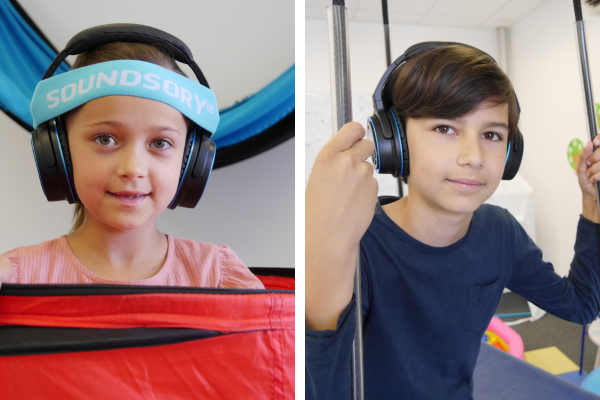
Many people often learn and think that there are only five senses. In reality, there are eight of them in total. Our senses are used every day to gather and respond to information within the environment. They are listed below:
- Sight (Vision)
- Hearing (Auditory)
- Smell (Olfactory)
- Taste (Gustatory)
- Touch (Tactile)
- Vestibular
- Proprioception
- Interoception
What is the Vestibular System?
The vestibular system is an important system that contributes to a person’s balance and orientation within space. This system provides our brain with information about changes in motion and head position during motor functions that allows a child or adult to maintain an upright posture or stabilize themselves during movement activities.
The vestibular system is important for everyday activities, such as our vestibular system working just from moving from a classroom chair to standing. One can move from one position to another position in a coordinated manner without falling over.
The vestibular system is made up of different components of the inner ear. The main components include the semicircular canal and otoliths. These components are responsible for detecting rotational movements and detecting linear movements in terms of acceleration and slowing down respectively. These parts of the inner ear are able to report the information to
various parts of the body, such as the cerebellum and brainstem to maintain balance and posture.
Vestibular System and Autism
Children with Autism Spectrum Disorder may experience some difficulties regulating sensory input. Some children may seek vestibular input to help calm their body, while it can also
be alerting. If a child with Autism appears like they are craving sensory input, they may benefit from some alerting activities to help them be successful in their daily lives. On the other hand, some children may be dysregulated, and they need more calming strategies to help them be
successful.
A quick example of each may be jumping and spinning verse slow rocking. Sensory experiences within the world can change quickly depending on what else is occurring within the
environment. One day something small may bother a child, but then the next day they may be able to tolerate the specific sensory input.
Signs and Symptoms of Autism Spectrum Disorder include a wide variety, as well as looks different in every child or adult. Some children with Autism Spectrum Disorder experience difficulties within their sensory system, specifically the vestibular system.
Vestibular dysfunction may include some of the characteristics that impact motor skills. They are listed below:
- Postural instability
- Gait Dysfunction
- Poor Core Strength
- Difficulty with Visual Processing and Spatial Awareness
- Poor Motor Coordination
- Difficulty with Visual Motor activities
- Uncoordinated and Awkward movements
- Poor Problem Solving
- Constantly bumps into furniture
- Seeking Vestibular
○ Constantly on the go
○ Tons of energy
○ Spinning around
○ No Fear of heights
○ Hyperactive - Avoiding Vestibular
○ Gravitational Insecurity
○ Scared of movement or climbing playground equipment
○ Difficulty navigating stairs
Vestibular Activity Examples
Linear movements are very calming to a child. Pairing linear movements and Soundsory may be beneficial to a child displaying some vestibular dysfunction. On the other hand, movement breaks are incorporated in between all the transitions within a therapy room and a
classroom.
Movement breaks can provide some quick input to a child to help them regain attention before transitioning to the next activity. Movement breaks are beneficial for a quick change of position for a child who may require more input, while linear movements with calming music may help settle a child that is having difficulty.
- Some activities may include:
Sensory Swing
○ Complete activities in seated, standing, or laying on stomach
○ Swing in linear movement or fast in circles
○ Complete activities in prone on the swing, such as reaching for a puzzle
piece. - Therapy Ball
○ Sit on a therapy ball and bounce up and down
○ Rock forward and back on it
○ Similar to a swing, roll over the top of it to reach for a puzzle piece. - Sit in the therapy room while completing an activity on a vertical surface
- Obstacle Courses
○ Challenge balance with a balance beam or wobble stones
○ Crawl back and forth through a tunnel - Scooter Board
○ Activities can be done seated, from the knees pushing through the arms, or
on the stomach in prone - Wheelbarrow walking
- Jumping, Skipping, and Galloping
Vestibular System and Soundsory
Soundsory identifies that movement is so important and a huge part of a child’s day. Soundsory pairs calming music with movement exercises to get the whole body and all of the sensory systems working together. The goal of Soundsory is to help the body and brain grow.
Soundsory uses a bottom-up approach by targeting the sensory system from the start, specifically the vestibular system. The next stage is the developmental stage. Branching off the sensory
system to focus on motor development to increase body awareness and motor skills to improve eye-hand coordination, visual-spatial awareness, and ocular motor control. Once these skills
begin to improve, the final level of the pyramid is the actual learning level. Bringing together the sensory experiences and developmental skills from the bottom two steps to improve everyday areas of social participation and academic skills.
Benefits of Soundsory:
- Balance: Assists the vestibular system with developing stability and strengthening the body.
- Postural Control: Supports upright posture for smoother movements during times of transitions.
- Spatial Orientation: Further developing the vestibular system to help the body
identify where it is in space to increase attention and participation - Vision: Keeping vision stable is crucial to the vestibular system to be able to
complete everyday tasks, such as reading a book. - Alertness: Through music and movement programs, the vestibular system and the other senses are working together to increase attention and alertness.
- Cognition: Tying together the senses and the motor skills to develop and increase cognitive learning.

